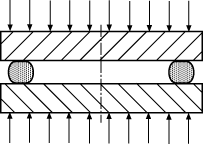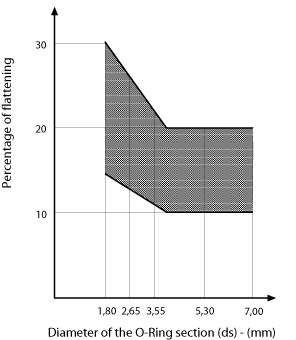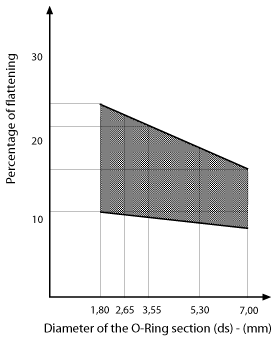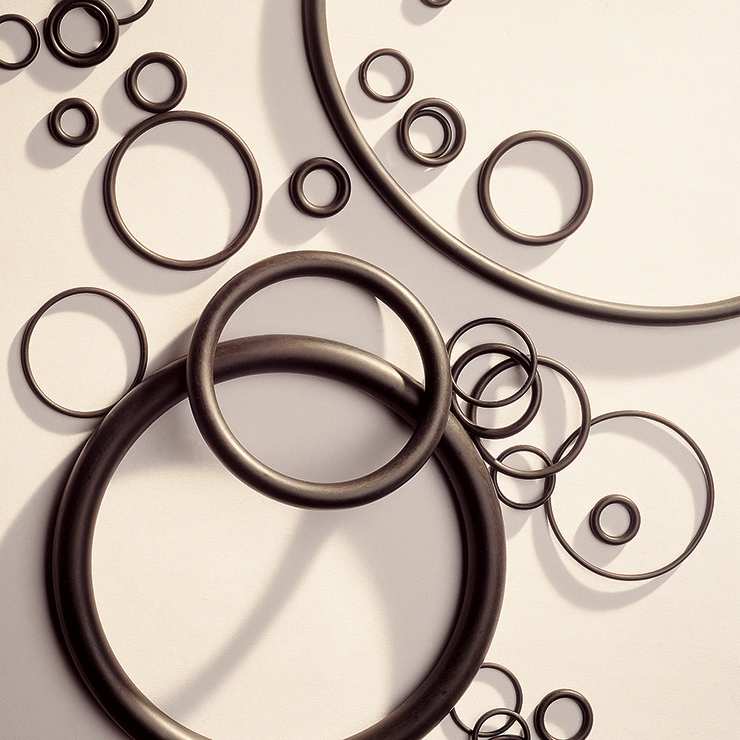Static seal and dynamic seal
The choice of a particular type of O-Ring, by dimensions and compound, depends first of all on the type of seal that it is required to exert. The O-Ring can exert static or dynamic sealing actions. In Table 3.1 below, we have shown the difference between the two types of seal.
Thanks to its form, the O-Ring can exert a seal with both radial stress and axial stress:
Thanks to its form, the O-Ring can exert a seal with both radial stress and axial stress:
- radial/apex seal (figure 3.3): the preloading deformation that guarantees the seal is exerted with forces that act on the level of the O-Ring;
- axial seal (figure 3.4): the preloading deformation for the seal is exerted with forces that act per pendicular to the level of the O-Ring.
 Figure 3.3
Figure 3.3Radial/apex seal
 Figure 3.4
Figure 3.4Axial seal
According to the components that make up the assembly and the positioning of the O-Ring, we can distinguish the sealing effect as one of three different types:
- cylinder seal (figure 3.5): the O-Ring is inserted in a suitable seat machined on the female element of the assembly and deformed with radial type preloading;
- piston seal (figure 3.6): the O-Ring is inserted in a seat machined on the component which constitu tes the shaft of the assembly, and the preloading deformation for the seal is of a radial type;
- flange seal (figure 3.7): the O-Ring is compressed between two flat parallel surfaces and subjected to preloading deformation of an axial type.
 Figure 3.5
Figure 3.5Cylinder seal
 Figure 3.6
Figure 3.6Piston seal
 Figure 3.7
Figure 3.7Flange seal
These types of seal can be used in both static and dynamic situations and each one stresses the O-Ring in a different way. The careful evaluation of the operating conditions allows the designer to choose the type of O-Ring that is best suited to the system.
There are many parameters that influence the sealing capacity of the O-Ring, from the level of superficial finishing of the surfaces in contact with the elastomer to the operating temperature, from pressure peaks to the nature of the fluid to be contained. As well as this, some of these factors that singularly may not cause negative effects, when combined may turn out to be highly damaging for the seal of the O-Ring. In static seal applications, the O-Ring is compressed inside the seating and the flattening (squashing/deflection?) to which it is subjected insures the seal. The value of this deformation must be correctly evaluated in order to guarantee good operation. In figure 3.8 we show in an approximate manner the recommended percentage of flattening in relation to the diameter of the O-Ring section.
The interval indicated is to be interpreted in relation to the varying elastic properties of the elastomers available: the better the elasticity of the material, the greater the flattening percentage must be in order to guarantee a good seal.
There are many parameters that influence the sealing capacity of the O-Ring, from the level of superficial finishing of the surfaces in contact with the elastomer to the operating temperature, from pressure peaks to the nature of the fluid to be contained. As well as this, some of these factors that singularly may not cause negative effects, when combined may turn out to be highly damaging for the seal of the O-Ring. In static seal applications, the O-Ring is compressed inside the seating and the flattening (squashing/deflection?) to which it is subjected insures the seal. The value of this deformation must be correctly evaluated in order to guarantee good operation. In figure 3.8 we show in an approximate manner the recommended percentage of flattening in relation to the diameter of the O-Ring section.
The interval indicated is to be interpreted in relation to the varying elastic properties of the elastomers available: the better the elasticity of the material, the greater the flattening percentage must be in order to guarantee a good seal.
Figure 3.8 – Recommended value of flattening percentage in relation to the diameter of the O-Ring
 Static seal
Static seal
 Dynamic seal
Dynamic seal
 Static seal
Static seal
 Dynamic seal
Dynamic seal
In static seal operating conditions one must not overlook the fact that important variations of pressure and temperature can cause relative movements between the O-Ring and the surfaces with which it is in contact, and therefore problems of wear and superficial damage that can compromise the seal. For this reason it is a good idea to accurately design the O-Ring's housing seats and guarantee a suitable level of superficial finishing.
Use in dynamic sealing applications subjects the O-Rings to friction due to rubbing along the seal surfaces and therefore, as well as wear, there are also problems related to the increase in temperature. In these types of applications the fluid circulating in the circuit can act as a lubricant, limiting the friction, in the light of small leaks due to scraping; in environments that are not particularly aggressive the presence of a thin layer of lubricant applied to the O-Ring can decrease wear. As we shall see, the increase of temperature and the reaction to contact can cause an increment in the volume of the O-Ring, triggering a chain process leading to the deterioration of the component and the loss of the seal. Another problem present in dynamic seal applications is extrusion; in fact the sliding of the surfaces and excessive friction combined with the excessive plastic behaviour of the compound can cause the extrusion of the O-Ring from the seat (figure 3.9).
Use in dynamic sealing applications subjects the O-Rings to friction due to rubbing along the seal surfaces and therefore, as well as wear, there are also problems related to the increase in temperature. In these types of applications the fluid circulating in the circuit can act as a lubricant, limiting the friction, in the light of small leaks due to scraping; in environments that are not particularly aggressive the presence of a thin layer of lubricant applied to the O-Ring can decrease wear. As we shall see, the increase of temperature and the reaction to contact can cause an increment in the volume of the O-Ring, triggering a chain process leading to the deterioration of the component and the loss of the seal. Another problem present in dynamic seal applications is extrusion; in fact the sliding of the surfaces and excessive friction combined with the excessive plastic behaviour of the compound can cause the extrusion of the O-Ring from the seat (figure 3.9).
 Figure 3.9
Figure 3.9a) O-Ring at rest - b) O-Ring during an attempt at extrusion
In the following paragraph we consider the principal physical and chemical stresses to which the O-Rings are subjected during their use in both static and dynamic seal applications.
Technical sheets
